January 2025
The global probiotics packaging market size is calculated at USD 6.21 billion in 2025 and is forecasted to reach around USD 11.53 billion by 2034, accelerating at a CAGR of 7.09% from 2025 to 2034. The North America probiotics packaging market size surpassed USD 1.98 billion in 2024 and is expanding at a CAGR of 7.23% during the forecast period. The market sizing and forecasts are revenue-based (USD Million/Billion), with 2024 as the base year.
The global probiotics packaging market size was accounted for USD 5.81 billion in 2024 and is anticipated to reach around USD 11.53 billion by 2034, growing at a CAGR of 7.09% from 2025 to 2034. Ongoing advancements in packaging technology, increasing consumption of probiotics, and the rising demand for innovative packaging solutions contribute to the growth of the probiotics packaging market.
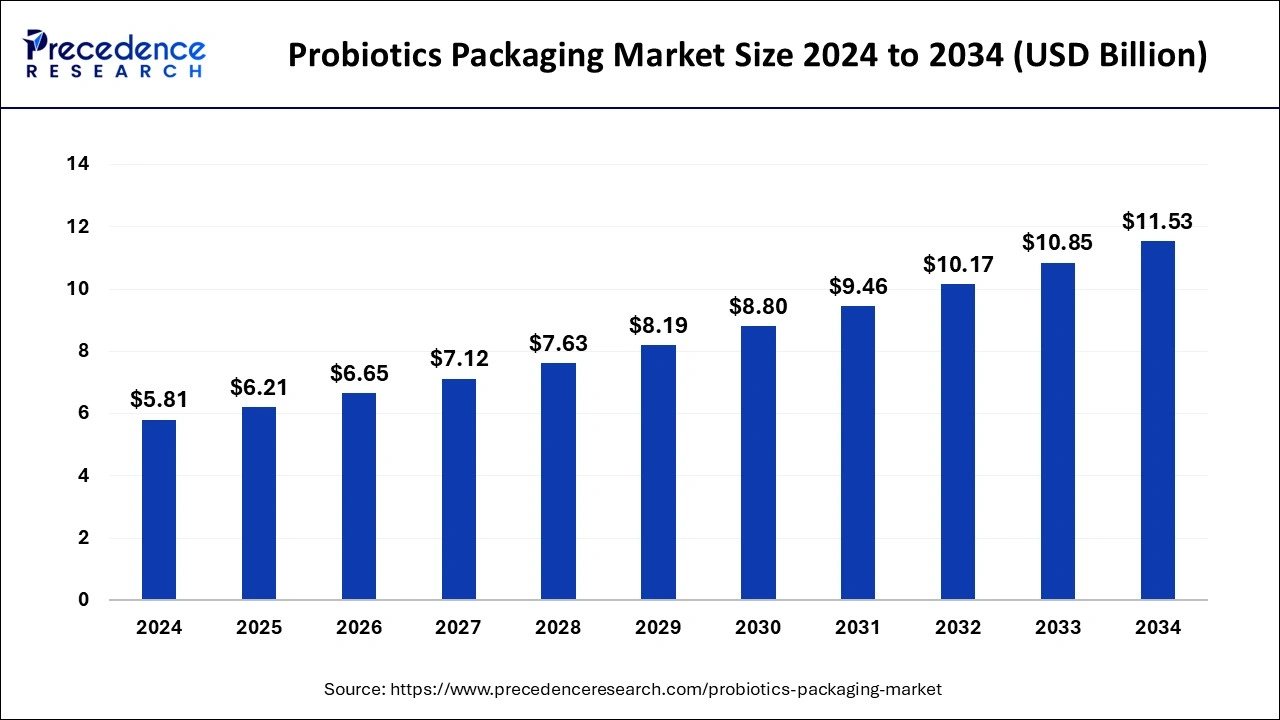
Artificial intelligence (AI) positively impacts the market. Integrating AI technologies in packaging manufacturing processes improves production output by automating various tasks. AI-driven technologies monitor packaging processes in real time and detect flaws, further reducing waste. They also help in the quality inspection process, ensuring that the final packaging product meets quality standards and is free of contamination. Moreover, AI helps in creating innovative packaging designs. It also helps in optimizing supply chain management by predicting inventory needs.
The U.S. probiotics packaging market size was evaluated at USD 1.48 billion in 2024 and is predicted to be worth around USD 3 billion by 2034, rising at a CAGR of 7.32% from 2025 to 2034.
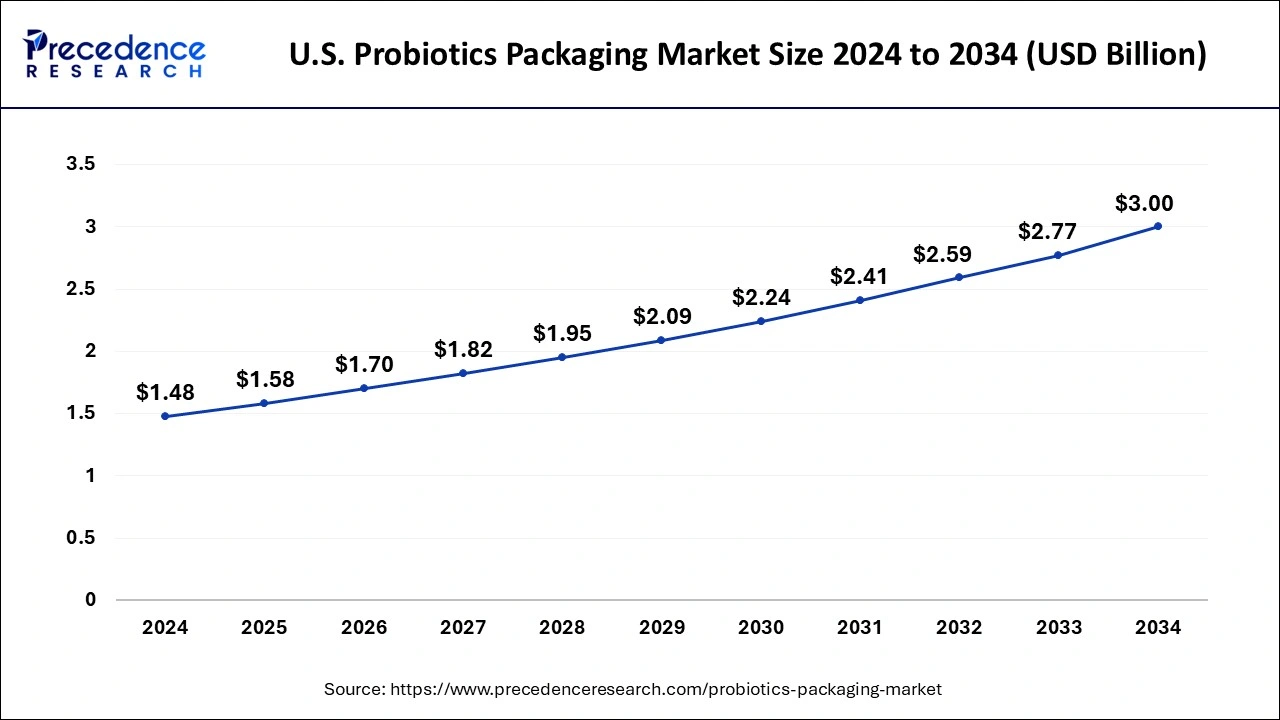
North America led the probiotics packaging market with the biggest market share of 34% in 2024. In North America, the probiotics packaging market is witnessing a growing emphasis on sustainable packaging materials. As consumers in the region become more eco-conscious, manufacturers are increasingly adopting recyclable and eco-friendly packaging options for probiotic products. Customized packaging formats tailored to specific product categories, such as probiotic-infused beverages and snacks, are also gaining traction. Additionally, the surge in e-commerce during the pandemic has boosted the demand for durable and protective packaging solutions suitable for online sales.
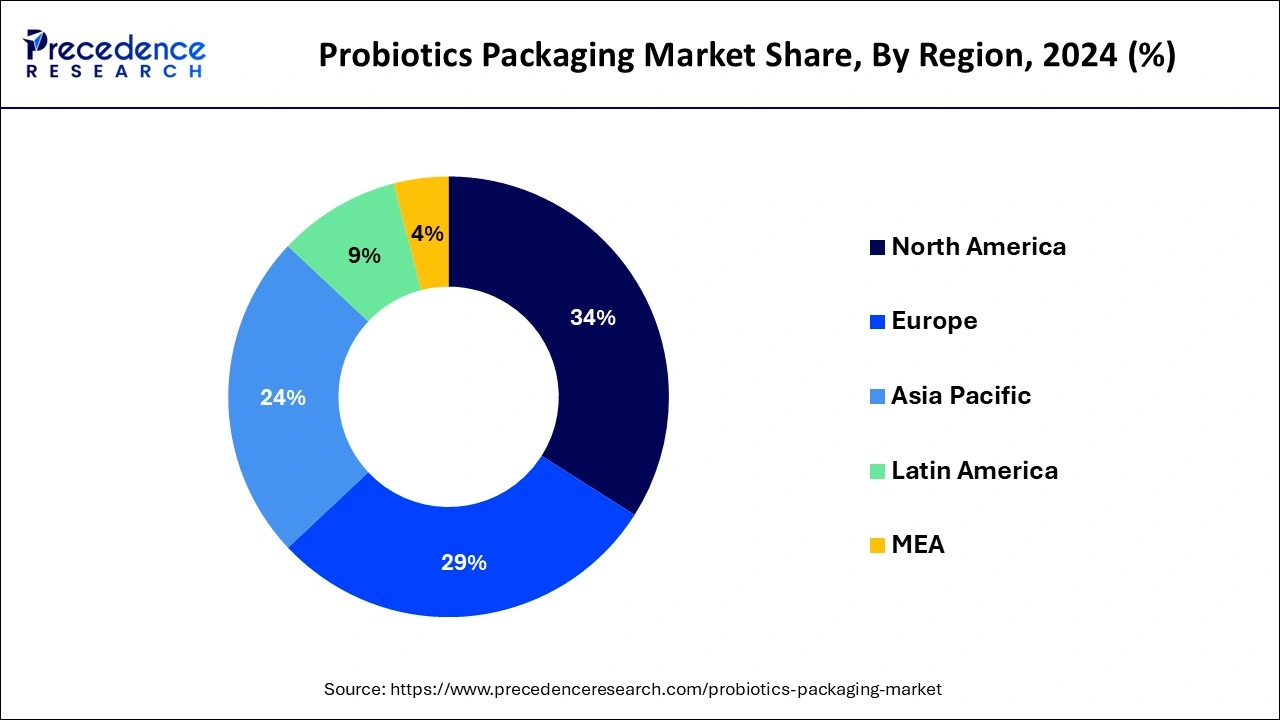
Asia Pacific is estimated to observe the fastest expansion. The Asia Pacific probiotics packaging market is characterized by a burgeoning health and wellness trend. As consumers prioritize digestive health, there is a rising demand for probiotic products, leading to a parallel demand for effective packaging that maintains probiotic efficacy. Sustainable packaging materials, particularly those aligned with traditional practices like biodegradable packaging, are gaining prominence in this region. Furthermore, Asia Pacific exhibits a growing preference for single-serve and convenient packaging formats, catering to on-the-go lifestyles and contributing to market growth.
Probiotic packaging refers to the specialized packaging designed for probiotic supplements and products containing live beneficial microorganisms like bacteria and yeast, known for their health benefits. This packaging ensures the viability and stability of probiotics by providing a controlled environment that protects these sensitive microorganisms from moisture, oxygen, and light, which can degrade their potency. Probiotic packaging often includes features such as moisture-resistant barriers, oxygen-absorbing materials, and dark or opaque containers. It plays a critical role in maintaining the efficacy and shelf life of probiotic products, ensuring consumers receive the promised health benefits when they consume these supplements or food items.
| Report Coverage | Details |
| Growth Rate from 2025 to 2034 | CAGR of 7.09% |
| Market Size in 2025 | USD 6.21 Billion |
| Market Size by 2034 | USD 11.53 Billion |
| Largest Market | North America |
| Base Year | 2024 |
| Forecast Period | 2025 to 2034 |
| Segments Covered | By Packaging Type, By Form, and By Distribution Channel |
| Regions Covered | North America, Europe, Asia-Pacific, Latin America, and Middle East & Africa |
Rising demand for probiotic products and advancements in packaging technologies
As consumers become increasingly health-conscious and aware of the benefits of probiotics for digestive health and overall well-being, there is a substantial uptick in the consumption of probiotic supplements and foods. This growing demand for probiotics directly translates into an increased need for specialized packaging solutions that can safeguard the viability and efficacy of these delicate microorganisms. Consumers seek assurance that the probiotics they consume retain their potency until the point of ingestion, making effective packaging a critical factor.
This demand for probiotic products, in turn, propels the demand for probiotics packaging, creating a symbiotic relationship between the two. Moreover, ongoing innovations in packaging materials and technologies have revolutionized the probiotics packaging market. These advancements allow for the development of packaging solutions that offer enhanced protection against moisture, oxygen, and light, factors that can compromise probiotic potency.
Cutting-edge packaging technologies enable the creation of barriers that shield probiotics from environmental conditions while ensuring convenient and consumer-friendly formats. This, in turn, instills confidence in both manufacturers and consumers that probiotics remain viable and effective, fostering a greater reliance on probiotic products and, consequently, a surge in demand for probiotics packaging solutions that facilitate their success.
Cost considerations and technical challenges
One of the significant restraints in the probiotics packaging market is the rising demand for cost-effective solutions. As the demand for probiotic products continues to surge, manufacturers are under pressure to offer competitively priced items. This puts a strain on packaging companies to develop packaging solutions that balance cost-efficiency with the necessary protection and stability requirements for probiotics.
Achieving this balance can be challenging, especially when incorporating specialized barrier materials and technologies. Consequently, cost considerations can limit the adoption of advanced packaging solutions, particularly in price-sensitive markets. Moreover, technical challenges also pose constraints on the probiotics packaging market. Preserving the viability of live probiotic microorganisms throughout the product's shelf life is a complex task. Probiotics are sensitive to factors like moisture, oxygen, and light, requiring packaging materials and structures that provide effective barriers against these elements.
Achieving the desired shelf stability while maintaining label transparency and regulatory compliance adds to the technical complexities. Furthermore, different probiotic strains may have unique storage requirements, demanding tailored packaging solutions. These technical intricacies can hinder the development and adoption of effective probiotics packaging solutions, affecting market growth.
Advanced barrier materials and customized packaging
As probiotic products gain popularity for their health benefits, preserving the viability of these sensitive microorganisms is paramount. Advanced barrier materials, such as specialized films and coatings, create a protective shield that shields probiotics from moisture, oxygen, and light. This ensures the probiotics remain potent throughout their shelf life. As consumers increasingly prioritize product efficacy, the demand for packaging that guarantees probiotic stability grows significantly. Moreover, the diverse landscape of probiotic products, ranging from supplements to functional foods and beverages, necessitates customized packaging solutions.
Tailored packaging allows manufacturers to optimize the design, size, and format of packaging to suit the specific requirements of different probiotic applications. This customization enhances the overall consumer experience, ensuring that probiotics are conveniently integrated into daily routines. Customized packaging also offers branding opportunities, allowing companies to differentiate their products in a competitive market. As the probiotics market diversifies, packaging solutions that can be adapted to these varied product types are in high demand, driving market growth.
The bottles segment contributed the highest market share of 33% in 2024. In the probiotics packaging market, bottles are a prevalent packaging type. These containers are typically made of plastic or glass and are favored for their durability and protective properties. They provide an airtight and moisture-resistant environment that helps maintain the viability of probiotics. A notable trend is the use of dark or opaque bottles to shield probiotics from light, which can degrade their potency. Additionally, manufacturers are increasingly adopting eco-friendly bottle materials in response to sustainability concerns, aligning with the broader environmental trends in packaging.
The sachets segment is expected to grow at a notable CAGR during the forecast period. They are single-serving, convenient, and often used for probiotic powders or granules. Sachets are known for their portability and ease of use, making them suitable for on-the-go consumers. A significant trend is the inclusion of moisture-resistant and oxygen-barrier materials in sachet designs to protect probiotics. Sachets also provide opportunities for branding and product differentiation through customizable packaging designs, catering to consumer preferences for diverse probiotic delivery formats.
The dry segment has held a major market share of 60% in 2024. Dry probiotics are typically found in powder or capsule form. Packaging for dry probiotics must provide excellent moisture and oxygen barrier properties to maintain probiotic viability. Trends in dry probiotics packaging include single-dose sachets for convenience, eco-friendly packaging materials, and clear labeling to highlight strain specificity and product efficacy.
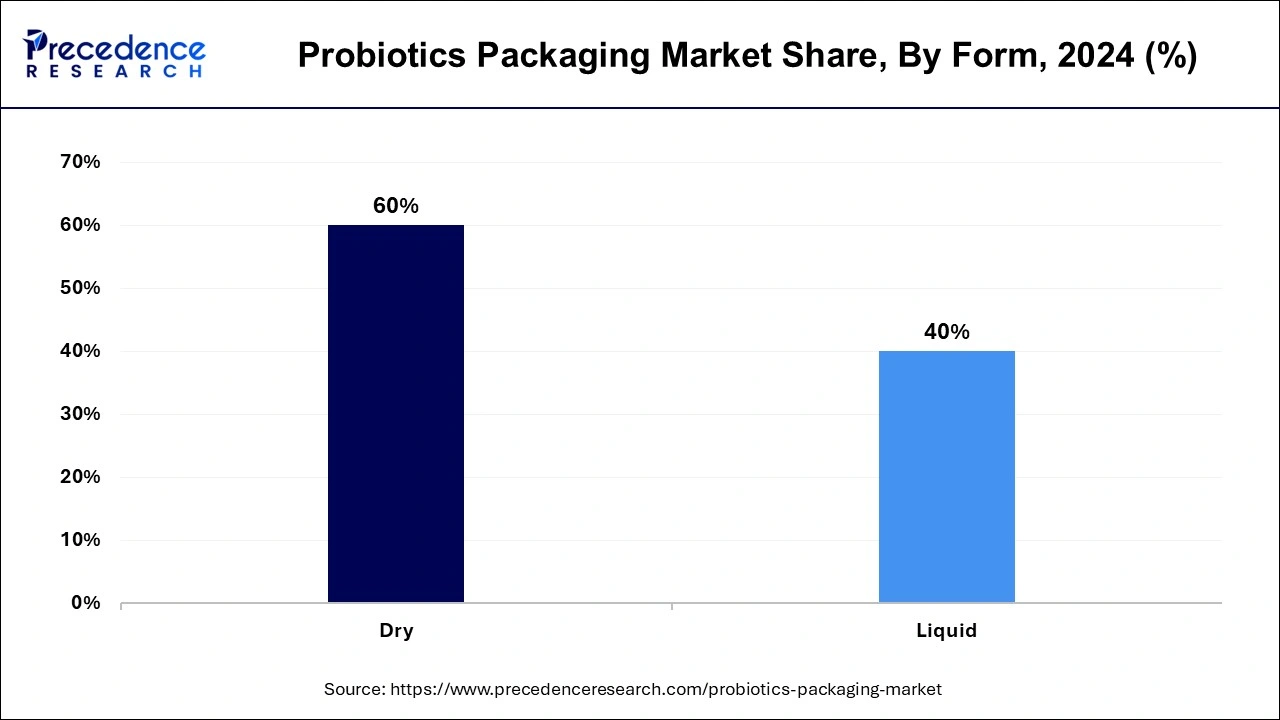
The liquid segment is anticipated to grow at the fastest rate during the forecast period. Liquid probiotics are often found in beverages and require packaging that prevents contamination and maintains freshness. Trends in liquid probiotics packaging involve the use of airtight bottles or containers with tamper-evident seals for product safety.
Sustainable packaging options, such as recyclable materials, are also gaining traction in response to environmental concerns. Additionally, packaging designs that enhance the product's visual appeal and nutritional claims are becoming more prevalent to attract consumers seeking liquid probiotic options.
The new pharmacist segment accounted for the largest market share of 38% in 2024. In the probiotics packaging market, the pharmacist distribution channel involves the sale of probiotic products through pharmacies and healthcare professionals. Pharmacists play a crucial role in educating consumers about probiotics and recommending suitable products. A growing trend in this channel is the emphasis on product efficacy and packaging integrity, as pharmacists prioritize probiotic packaging that ensures the stability and potency of these live microorganisms. Additionally, packaging that offers clear dosing instructions and information about the health benefits of probiotics is becoming more prevalent in this distribution channel.
The online segment is anticipated to expand at the fastest rate over the projected period. The online distribution channel for probiotics packaging has witnessed significant growth, accelerated by the COVID-19 pandemic. Consumers increasingly prefer the convenience of purchasing probiotic products online, leading to an expansion of e-commerce platforms. In this channel, the packaging trends focus on product protection during shipping, with an emphasis on tamper-evident seals and secure closures. Additionally, online retailers often offer a wide range of probiotic brands, fostering competition based on packaging innovation, such as eco-friendly materials and customizable options, to stand out in the digital marketplace.
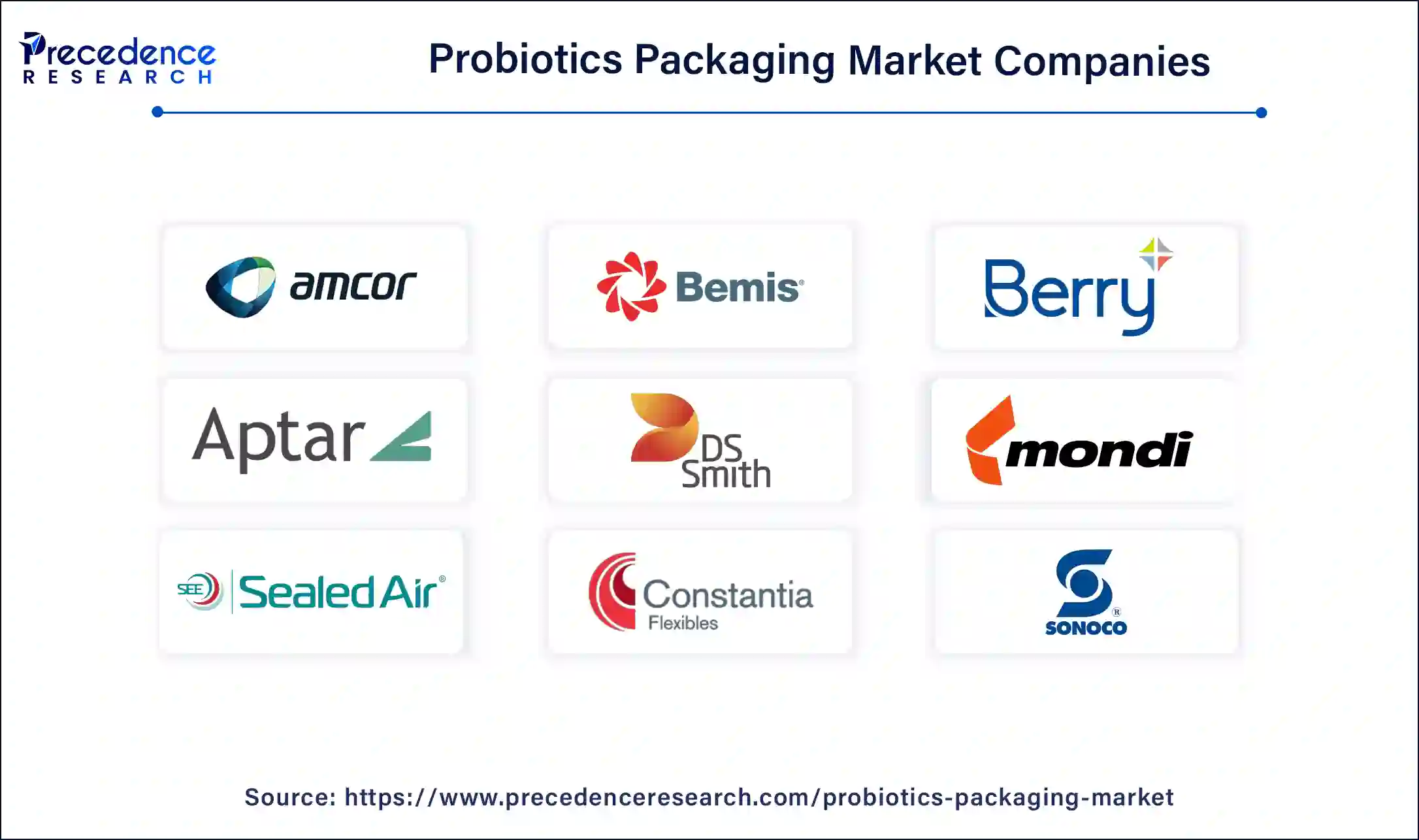
By Packaging Type
By Form
By Distribution Channel
By Geography
For inquiries regarding discounts, bulk purchases, or customization requests, please contact us at sales@precedenceresearch.com
No cookie-cutter, only authentic analysis – take the 1st step to become a Precedence Research client
January 2025
January 2025
January 2025
March 2025